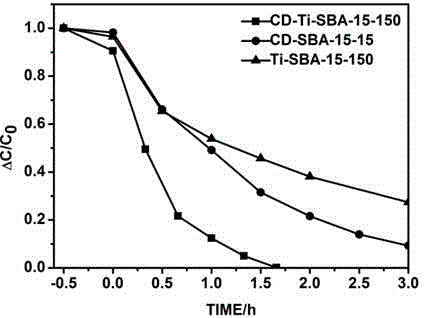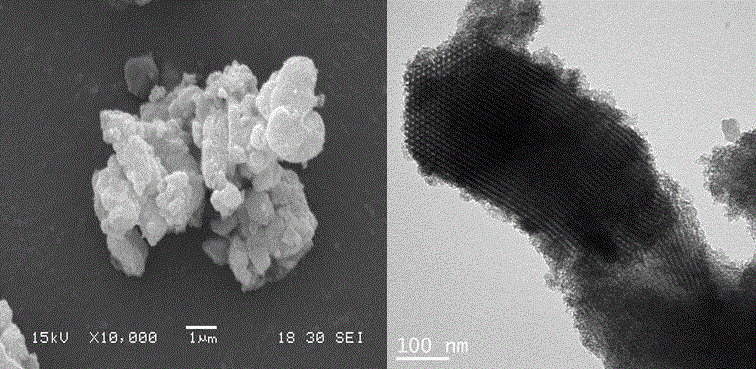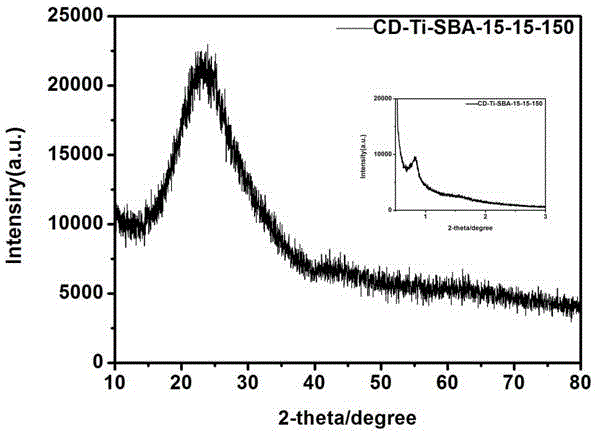Carbon quantum dot and titanium codoped mesoporous silica composite photocatalyst
A technology of mesoporous silica and mesoporous silica, applied in the field of photocatalysis, achieves high specific surface area, convenient operation and reduced production cost
- Summary
- Abstract
- Description
- Claims
- Application Information
AI Technical Summary
Problems solved by technology
Method used
Image
Examples
Embodiment 1
[0029] Weigh 1.33g of P123, 1.467g of chloride in a 100ml three-neck flask, dissolve in 20ml of 4M hydrochloric acid solution, add 20ml of deionized water, stir vigorously with mechanical stirring for 3 hours at 38°C to dissolve, reduce the stirring speed to avoid a large number of bubbles, A mixed solution of 3ml tetraethyl orthosilicate, 200ul carbon quantum dots and 20ul tetrabutyl titanate was added, stirred for another two minutes, and left to stand at 38°C for 24h. Transfer to a tetrafluoroethylene hydrothermal kettle, heat at 100°C for 24 hours, cool, filter and wash with water, wash with water three times, and dry in a vacuum oven at 60°C for 12 hours to obtain a sample. After the template agent is extracted, the sample is placed in a tube furnace, and the temperature is programmed to rise in a nitrogen atmosphere at a rate of 1°C / min, and it is calcined at 450°C for four hours, and then cooled naturally to obtain carbon quantum dots and titanium co-doping mesoporous s...
Embodiment 2
[0031] Weigh 1.33g of P123, 1.467g of chloride in a 100ml three-neck flask, dissolve in 20ml of 4M hydrochloric acid solution, add 20ml of deionized water, stir vigorously with mechanical stirring for 3 hours at 38°C to dissolve, reduce the stirring speed to avoid a large number of bubbles, Add 3ml tetraethyl orthosilicate, 200ul carbon quantum dots mixed solution, stir for two minutes, and let stand at 38°C for 24h. Transfer to a tetrafluoroethylene hydrothermal kettle, heat at 100°C for 24 hours, cool, filter and wash with water, wash with water three times, and dry in a vacuum oven at 60°C for 12 hours to obtain a sample. After the template agent is extracted, the sample is placed in a tube furnace, and the temperature is programmed to rise in a nitrogen atmosphere at a rate of 1°C / min, and it is calcined at 450°C for four hours, and then cooled naturally to obtain carbon quantum dot-doped mesoporous pores. Silica composite photocatalyst.
Embodiment 3
[0033] Weigh 1.33g of P123, 1.467g of chloride in a 100ml three-neck flask, dissolve in 20ml of 4M hydrochloric acid solution, add 20ml of deionized water, stir vigorously with mechanical stirring for 3 hours at 38°C to dissolve, reduce the stirring speed to avoid a large number of bubbles, A mixed solution of 3ml of tetrabutyl titanate and 3ml of tetrabutyl titanate was added, stirred for another two minutes, and left to stand at 38°C for 24h. Transfer to a tetrafluoroethylene hydrothermal kettle, heat at 100°C for 24 hours, cool, filter and wash with water, wash with water three times, and dry in a vacuum oven at 60°C for 12 hours to obtain a sample. After extracting the template agent, the sample was placed in a tube furnace, and the temperature was raised under a nitrogen atmosphere at a rate of 1°C / min, then raised to 450°C for four hours and then cooled naturally to obtain titanium-doped mesoporous silica. composite photocatalyst.
PUM
| Property | Measurement | Unit |
|---|---|---|
| specific surface area | aaaaa | aaaaa |
Abstract
Description
Claims
Application Information
 Login to View More
Login to View More - R&D
- Intellectual Property
- Life Sciences
- Materials
- Tech Scout
- Unparalleled Data Quality
- Higher Quality Content
- 60% Fewer Hallucinations
Browse by: Latest US Patents, China's latest patents, Technical Efficacy Thesaurus, Application Domain, Technology Topic, Popular Technical Reports.
© 2025 PatSnap. All rights reserved.Legal|Privacy policy|Modern Slavery Act Transparency Statement|Sitemap|About US| Contact US: help@patsnap.com



